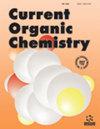Hemisynthesis of Pentacyclic Triterpenoids from Diospyros foxworthyi with in vitro and in silico Anti-malarial Evaluation
IF 2.1
3区 化学
Q3 CHEMISTRY, ORGANIC
引用次数: 0
Abstract
: A total of twelve pentacyclic triterpenoid derivatives based on betulin (1) and lupeol (2) scaffolds isolated from Diospyros foxworthyi were hemisynthesized by acylation or acetylation reactions with appropriate acid chloride or acetic anhydride. The structures of the hemisynthesised compounds were characterised by means of FT-IR, 1D- and 2D-NMR, as well as HRMS analysis. These compounds were assayed for in vitro anti-malarial studies by inhibition of β-hematin formation assay with chloroquine as a positive control. Compounds 1d and 2f showed the strongest potential as β-hematin formation inhibitors with IC50 values of 6.66 ± 1.36 and 11.89 ± 0.15 µM, respectively, compared with the positive control (chloroquine; IC50 = 37.50 ± 0.60 µM). In silico molecular docking simulations were performed using AutoDock Vina for compounds 1d and 2f to investigate the binding interactions and free energy of binding (FEB) with the hemozoin supercell crystal structure (CCDC number: XETXUP01). The findings revealed several hydrophobic interaction modes between the 1d, 2f and hemozoin, with calculated FEBs of -8.4 ± 0.2 and -8.9 ± 0.0 kcal mol-1 , indicating strong and favourable interactions.福寿果五环三萜类化合物的半合成及体外和硅学抗疟疾评价
:通过与适当的氯化酸或乙酸酐进行酰化或乙酰化反应,半合成了基于从狐狸喜树(Diospyros foxworthyi)中分离出的白桦脂素(1)和羽扇豆醇(2)支架的十二种五环三萜类衍生物。通过傅立叶变换红外光谱、一维和二维核磁共振以及 HRMS 分析,对半合成化合物的结构进行了表征。以氯喹为阳性对照,通过β-半胱氨酸形成抑制试验对这些化合物进行了体外抗疟疾研究。与阳性对照(氯喹;IC50 = 37.50 ± 0.60 µM)相比,化合物 1d 和 2f 的 IC50 值分别为 6.66 ± 1.36 µM 和 11.89 ± 0.15 µM,显示出作为 β-海马汀形成抑制剂的最强潜力。使用 AutoDock Vina 对化合物 1d 和 2f 进行了硅学分子对接模拟,以研究其与血安宁超细胞晶体结构(CCDC 编号:XETXUP01)的结合相互作用和结合自由能(FEB)。研究结果表明,1d、2f 和安息香素之间存在几种疏水相互作用模式,计算出的自由结合能分别为 -8.4 ± 0.2 和 -8.9 ± 0.0 kcal mol-1,表明它们之间存在强烈而有利的相互作用。
本文章由计算机程序翻译,如有差异,请以英文原文为准。
求助全文
约1分钟内获得全文
求助全文
来源期刊

Current Organic Chemistry
化学-有机化学
CiteScore
3.70
自引率
7.70%
发文量
76
审稿时长
1 months
期刊介绍:
Current Organic Chemistry aims to provide in-depth/mini reviews on the current progress in various fields related to organic chemistry including bioorganic chemistry, organo-metallic chemistry, asymmetric synthesis, heterocyclic chemistry, natural product chemistry, catalytic and green chemistry, suitable aspects of medicinal chemistry and polymer chemistry, as well as analytical methods in organic chemistry. The frontier reviews provide the current state of knowledge in these fields and are written by chosen experts who are internationally known for their eminent research contributions. The Journal also accepts high quality research papers focusing on hot topics, highlights and letters besides thematic issues in these fields. Current Organic Chemistry should prove to be of great interest to organic chemists in academia and industry, who wish to keep abreast with recent developments in key fields of organic chemistry.
 求助内容:
求助内容: 应助结果提醒方式:
应助结果提醒方式:


